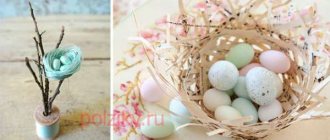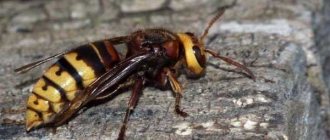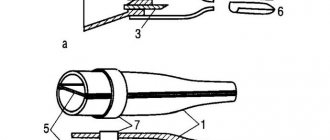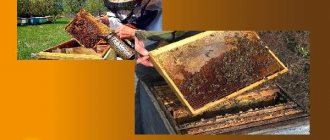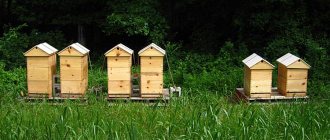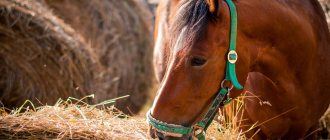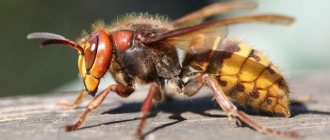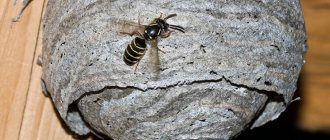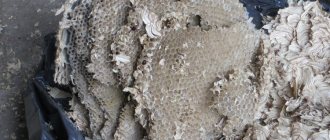Bird nests placed by birds on trees are cute and interesting, but homemade decorative crafts made from twigs like a house for birds are a completely different matter from the design sphere. The popularity of decorating the interior with such “fluffies” with toy eggs or figurines seated in them is becoming more and more widespread, which makes the algorithms for making them yourself more and more in demand.
Anyone can cope with this task, and the photos below of possible nests made from branches, options for using them in the interior, and recommendations for using such decorations will help with this.
Chicken nests
How to make nests for laying hens from boxes. Such short-lived nests are made for temporary housing of birds from clean, high-quality materials.
How to make chicken nests for eggs. The simplest way is to cut an opening in the box, and the birds quickly get used to such nests, in which a different number of cells can be made.
Dimensions
When building nests, it is necessary to take into account the breed of chickens:
- For ordinary laying hens, small structures with the following parameters will be sufficient: 25x35x35 cm.
- Individuals of meat and egg breeds need more spacious shelters with dimensions of 30x40x45.
Each nest (regardless of the breed) must have a threshold with a height of 5 to 8 cm, as well as a special bar designed for birds to take off (located ten centimeters from the entrance and having a cross-section of 5x2 cm).
With a large number of laying hens, it is advisable to place nests in 2-3 tiers, making sure that the height of the nests of the lower tier is at least 30-40 cm from the floor level.
Above the upper tier it is necessary to make a reliable roof with an angle of inclination equal to 45-50 degrees (such a slope is needed in order to wean chickens from the habit of sitting on the roof and soiling nests with their droppings).
duck nest
The duck nest must meet the following requirements: complete sound insulation, minimal lighting, thick, dry bedding.
For construction you will need: screws, a ruler, sheets of plywood, 6 wooden slats, a saw.
Sequence of work:
- Two square blanks 0.4 x 0.4 m are made from a sheet of plywood;
- For the entrance, a square hole of 0.17 x 0.17 m is cut at a height of 9 cm;
- Square side walls with sides of 0.4 and 0.5 m and a roof are manufactured;
- A frame is constructed from slats;
- The parts are attached to the frame;
- Bedding is placed at the bottom, which needs to be replaced regularly. For the bottom material, the use of wood is preferable, but iron is undesirable.
In order to teach a bird to lay eggs only in a built nest, you should put imitation eggs made of plaster or chalk in it and not collect eggs in their presence.
Where can I place it?
After the process of making the craft reaches the finish line, you can think about placing the product. So, the following options are offered:
In the house. You can decorate any room in an apartment or house with a nest - the personification of comfort, family and warmth. The decoration looks especially good with a container of cereal or painted eggs placed in it.
On the street. A decorative nest for the garden is an interesting addition to any fence or a custom feeder for outdoor birds. You can try to find new residents by hanging a nest on the top of a tree.
As a present. A standard packaging box with a bow or a boring package is nothing compared to a bird's nest design. To give it a festive look, all you have to do is sprinkle the craft with glitter and add a shiny ribbon to the weave.
A decorative nest is one of those crafts whose simplicity of manufacture hides originality, practicality and incredible aesthetics. All that remains is to find suitable branches to decorate the interior of the living room or garden with an original accessory.
Geese nests
The goose's nest should be spacious, and the material for it can be unnecessary baskets, boxes and car tires.
The nest is at least 60 cm high and is installed in a dark place so as not to disturb the birds. If several birds are planning to hatch eggs in the nest, it should be divided into several compartments.
Required materials and accessories: saw, hammer, ruler, clapboard, bedding material, plywood.
Stages of work:
- The lining is sawn into strips for walls of 50 and 60 cm;
- Slats are nailed to 4 slats at a distance of 4 cm;
- The bottom is made of plywood;
- Treat the finished nest with a disinfectant solution.
Results of collective creativity
Nest of social weavers
Nest of social weavers
Let us now move from East Africa, in the savannas of which most varieties of true weavers live, to the Namib Desert, which stretches in a narrow strip along the coasts of the Atlantic in the southwest of the African continent, washed by the cold Benguela Current. The local region has a harsh climate and is not rich in birds.
But what ornithologist would refuse the opportunity to visit this inhospitable region, under the gloomy name of the Skeleton Coast? After all, it is here that you can see one of the main wonders of the bird construction industry - the collective nest of social weavers.
The result of collective creativity is noticeable from afar and resembles a large shock of hay, swept up at someone’s whim not on the ground, but in the crown of a tree. Such “heads” are especially often encountered on woody cockerbum lilies with their extremely thick succulent (succulent) trunk, which serves as a reservoir of moisture, and a rounded cap of short and gnarled branches. The “mock” is attached to the thickest branches and is a cone-shaped, tightly compressed mass of dry grass, covered on top with a thick and durable layer of densely packed thorny twigs and rough plant stems, forming a kind of roof.
Nest of social weavers
Residential nesting chambers are located in the lowest layer of soft material. Their entrances face down and are located close to each other, so that when viewed from below, the picture somewhat resembles a honeycomb. Above the residential nests, several floors high, there are old nests, long abandoned by the owners and completely filled with nesting material.
The maximum height (or thickness) of collective nests reaches one meter, the circumference is 3-4 meters. Dozens of generations of weavers are engaged in the construction of these grandiose buildings, which live to be centuries old; up to 500 individuals simultaneously coexist in large nests. Having served its purpose, the “stack” breaks its support and falls to the ground.
The population of the colony is concerned with the delivery and installation of material all year round. In winter, the weavers have little interest in the lower surface and mainly while away the time on the roof, where with great diligence they drag coarse dried stems of weeds and dry and thorny branches of acacias. It is flattering for each to place his offering above the others, which is why the roof inevitably takes the shape of a fairly regular cone-shaped dome.
With the arrival of spring, the birds' attention increasingly shifts to the “soft underbelly” of the building, that is, to its lower surface. Having found a place here and hanging on its paws with its back down, the weaver begins to carefully and methodically insert the ends of the grass blades sticking out into the thickness of the material with its beak. This work, needless to say, requires patience. Eventually a hole is formed on the lower surface of the soft layer, which, using the same painstaking technique, deepens and widens until it reaches the volume of the nesting chamber.
At the same time, at some point, the builder begins to bring additional blades of grass to the “construction site” and, acting in the usual way, inserts them into the material around the hole. Thus, the layer of material grows even more, and the nesting chamber sinks faster and faster into its thickness. Thus, the nesting structure of a colony of social weavers increases all year round, but in winter it grows upward, while with the beginning of the nesting season it grows downward.
The most amazing nest is built by the African Remez: being generally similar to the nest of the common Remez, it has two entrances. The false dead-end entrance is clearly visible from the outside, but as for the entrance to the nest room, it is often difficult to see, because it is covered by a soft entrance tube, which is not very easy to penetrate even for the owners.
Construction work at the remez is carried out exclusively by males. A single male lays the foundation of a building and attracts a female by singing. If she is gone for a long time, the male erects a new building nearby and sings near it. The construction technology is unique. Arriving at the construction site with a bunch of soft plant fibers in his beak, the male strengthens them at one end on a supporting branch and begins to quickly circle around it, catching his paws and winding the fibers onto the base, like thread on a spool. In an hour, the “builder” brings nesting material 10-15 times. After 3-4 hours of work, the male connects the wrapped twigs to each other with a crossbar from a bunch of grass, so that the base of the nest is formed in the shape of a triangle or ring. Now the male begins to wear not only elastic plant fibers, which are used to strengthen the base of the building, but also large tufts of fluff, which are stuck in different places between the fibers and gradually form the walls of the nest.
Already at the end of the first day of construction, the nest takes the form of a miniature and neat basket with a handle that is thicker and wider at the base. Subsequently, the side edges of the basket become higher and higher, the holes become smaller and finally the roof arch closes. Now all that remains is to attach the entrance vestibule in the form of a tube, and the nest is ready. Let us note that exactly the same sequence of actions, even down to coincidence in the smallest details, is characteristic of the already mentioned weavers, who also build hanging nests, but use other materials and a different technology for fastening them.
During construction, males are forced to vigilantly guard the territory around their nests, because if they are neglected, buildings, especially unfinished ones, can be destroyed by other males, who consider other people's (as well as abandoned last year's) nests just as a warehouse for nesting material.
The family life of the Remez looks rather bizarre; the marriages of these birds are usually very ephemeral. After the formation of a pair, the male remez quickly completes the construction (sometimes with the participation of the female) and in the future can devote himself to incubating the clutch, or maybe fly off on a trip and in the same summer acquire a new family at a distance of 25-30 kilometers from the previous one.
Many males are so overwhelmed by the building instinct that they often try with all their might to complete the construction of a ready-made nest with clutches, causing displeasure and even direct aggression from females who show well-founded fears for the safety of the eggs. In turn, some females manage to lay up to three clutches in the nests of different males over the summer. Some females leave the clutches in the care of the males, some remain to incubate - alone or with the help of their spouses. Many clutches die because the parents quarrel all the time and cannot “agree” on which of them will be the hen.
Willow nest
How to make a chicken nest woven from willow twigs. Stages of work:
- A cross is woven from willow twigs;
- The cross is braided using the crossing method. In this case, each turn is pressed with force against the previous one. After braiding, the diameter of the cross should be 0.7 m;
- Side rods with pointed ends are inserted and the sidewall is woven;
- The edges are braided. The ends of the rods are fastened in the center with wire;
- A spacer ring is fixed inside the basket;
- At a height of about 20 cm, the previously tied rods are untied and the edges of the basket are braided with them;
- Each rib is wrapped around the next one, and the third is folded 5 cm and cut off;
- After weaving the last rod, the protruding ends of the rods are cut off.
In case of difficulties, it is recommended to familiarize yourself with the videos posted on the World Wide Web on how to make a nest from willow branches on your own.
The threatening pose of a goose when a person approaches indicates that the time has come to take care of the nest in which it will hatch eggs.
The nest should be disinfected with a special composition and bedding should be made of hay (straw is not suitable for this purpose).
During the incubation period, there should be enough water and food near the nest. In winter, nests are placed in heated rooms.
If there are several nests with females nearby, their view should be limited by curtains to prevent mutual observation. Adequate ventilation is also necessary.
"Carpenters" and "diggers"
Woodpecker nests
The woodpecker's hollow is yellow (black woodpecker)
What professions have birds not mastered in pursuit of maximum comfort and safety of their nests! Some even had to master the skills of carpenters and diggers. These skills for both are based on the skillful use of the same working tool - their own strong beak, which, depending on the circumstances, can be used as a chisel or instead of a shovel. Therefore, the professions of a carpenter and a digger in the world of birds are quite closely related to each other.
Most of the 200 species of woodpeckers distributed throughout the world are native forest dwellers, and their art of handling trees has no equal. When the main forest "carpenter" - Zhelna - gets excited and gets down to business seriously, chips up to fifteen centimeters long scatter like a fountain around the "construction site". Zhelna is the largest of our woodpeckers, almost the size of a crow, so she needs a spacious “apartment”. The depth of its hollow reaches 40 centimeters, the internal diameter is 25 centimeters.
Interesting: Bowerbird nests: photos and videos
“Construction” is carried out by both partners in turn, and it rarely takes less than two weeks. The work takes place at a height of no lower than 3 meters from the ground, and some pairs climb almost 15 meters. Therefore, in early spring, before the grass has risen, a tree favored by yellow grass can be seen from a distance by large white chips lying at a distance of up to 10-12 meters from the trunk. The hollow of this species, even long abandoned by the “builders,” is easy to recognize by the shape of the entrance—usually it is not round, like those of other woodpeckers, but elliptical, and sometimes almost rectangular, elongated along the trunk.
Old woodpecker hollow
Most woodpeckers hollow out a new “home” for themselves every year , transferring the old one to the “secondary market” and acting as real benefactors in relation to other birds that have a chronic need for hollows. The hollows of the great spotted woodpecker, the most numerous and widely known “carpenter” of Russian forests, are inhabited mainly by small songbirds - flycatchers, redstarts, and tits. They are completely satisfied with a room with a diameter of 14-15 and a depth of 20-25 centimeters. But the activity of the nest is especially important and even irreplaceable for forest birds, whose voluminous hollows provide shelter for such large birds as owls, pigeons, mergansers and goldeneyes.
In modern forests, old hollow patriarch trees have almost disappeared, so it is almost impossible for owls, owls, and crows to find a natural hollow of suitable size. Unlike other woodpeckers, who tend to change places of residence every year, the woodpecker retains a long-term attachment to old hollows, which does not, however, prevent it from building new ones in the spring - “in reserve.” Despite all their dexterity, woodpeckers still rarely dare to gouge a hollow in the hard wood of a completely healthy tree from start to finish. Therefore, almost all woodpeckers consider aspen to be their favorite tree to go under hollows, with its soft wood susceptible to heart rot. It is possible that by tapping on the trunk before starting “construction”, the woodpecker determines by ear whether it is worth starting work on this particular tree or whether it is better to look for another.
The pygmy woodpecker, one of the smallest representatives of forest carpenters, lives well in the bamboo forests of the Himalayas and Indochina. The bamboo trunk is hollow inside and divided into sections by partitions-internodes. It is enough for the bird to hollow out the wall of the trunk 10-20 centimeters above the internode - and it has a completely ready-made nesting chamber at its disposal.
The red-headed woodpecker, which lives in the same region, does not build a hollow at all, but hatches its chicks inside the massive and certainly residential nests of large wood ants, nicknamed “fire ants” for their lively character and readiness to immediately and for any reason use their powerful jaws and poisonous sting.
The building material for ants is a unique and quite durable “cardboard” made from wood fibers thoroughly chewed and mixed with saliva. Woodpeckers make a hole about 5 centimeters in diameter in the shell of an ant's nest and lay their eggs right among the insects' brood chambers. The secret of the loyalty of ants, whose incredible aggressiveness is known to all inhabitants of the jungle, in relation to woodpeckers has not yet been solved, especially since the feathered tenants are not distinguished by their modest disposition and regularly eat ant pupae, without even interrupting their incubation.
Common kingfisher burrows
Burrow of a common kingfisher
When it comes to digging burrows, kingfishers are great masters. They dig with their beaks, and scoop out the earth from the tunnel with their paws, moving back towards the entrance, so deftly that clay and sand fly out of the hole like a fountain. When choosing a more convenient place, many birds lay several holes at the same time, often at a decent distance from each other. In the morning, the kingfisher works on one cliff, in the afternoon it flies to another, and in the evening, you see, clay is already falling from the third.
Digging a hole requires concentrated effort and takes a lot of strength. But the kingfisher couple works with great enthusiasm, and the spouses not only do not shirk their work, but strive to make as significant a contribution to the construction as possible and wait with great impatience for their turn.
The finished hole is a narrow tunnel from thirty centimeters to three meters long, which runs horizontally or with a slight slope. The hole's entrance always faces the river, and in its depths there is a round nesting chamber the size of an apple. This is the nursery, in which up to five chicks can develop freely.
Among birds there are many species that do not bother themselves with carpentry or excavation work, but willingly live in ready-made hollows and burrows. Residents of each type have their own requirements for the premises. For example, great tits occupy the darkest and deepest hollows and do not tolerate crevices in artificial nesting boxes. On the contrary, pied flycatchers, which are also committed to nesting in hollows, do not like darkness, which is why the peculiar effect of “aging nests” has become known in the practice of attracting birds. Its essence is that flycatchers most readily occupy recently hung nest boxes with light-colored walls from the inside, but almost never populate nests that have been hanging for many years, the walls of which have become dark gray over time. But it is enough to whitewash the inside of these nesting places, they again become attractive.
Wooden pigeon nest
You will need the following materials and tools:
- Metal mesh;
- Hammer and nails;
- Saw, ruler;
- Sandpaper;
- Wooden bars.
Sequence of work:
- Sand the bars;
- Saw the bars according to the markings;
- Make a mesh bottom;
- Assemble the parts into a single structure.
Styrofoam nest
In addition to polystyrene foam, you will need glue and a saucepan for production.
Sequence of work:
- Mark the foam;
- Cut into rectangular pieces;
- Cover the foam with parchment paper;
- Heat water in a saucepan, place it on the parchment and, pressing it, make a hole;
- Cover all parts with glue and then with a bandage for strength.
Nest designs
- Pillars made of any material can serve as support for the nests.
- The wooden base for the roof nest is made from boards nailed to the crosspieces and then attached to the roof ridge.
- On top of this base, a platform, grate or wheel is attached with nails.
Only professionals can arrange a site for black stork nests.
Nesting boxes for guinea fowl
Guinea fowls lay eggs during the warm season in nests made of blades of grass and branches, which they build themselves. Guinea fowl do not hatch eggs in artificial nests.
If overly timid guinea fowl abandon the clutch, the hen can continue to hatch without harm to the offspring.
Pheasant nest
These birds prefer to hatch their eggs indoors. A small depression measuring from 1.3 to 2.5 m is created in a layer of peat, covered with turf and dry grass on top. The enclosure is sown with millet, rapeseed and other plants.
Making an aviary:
- Metal, concrete or wooden poles are installed in holes filled with cement;
- A metal mesh is stretched between them;
- The roof is mounted on top. If necessary, rafters are installed.
Turkey nest
From the very beginning, care should be taken to ensure that the nest is located in a quiet, dark, draft-free, warm place. The floor of the turkey house is covered with hay and straw, earth or branches
The nests can be made of wooden boxes, which should be thoroughly cleaned, treated with a disinfectant and dried. After laying the bedding, the nest should be fenced off with a screen.
Brick nest option
One row of bricks is laid on a pad of cotton padded jacket. In a nest equipped with an egg collector, the bottom consists of several parts; a container for collecting eggs is placed under it.
The litter requires daily replacement, and eggs should be collected as often as possible at a minimum cool temperature. Eggs are stored in a fairly dry room with no odors.
It should be remembered that if the bird does not like the nest, it needs urgent rework. Otherwise you will not get good quality eggs.
Small grebes raft houses
Birds of the Grebe family spend most of their lives in fresh water bodies framed by well-developed marsh vegetation. They are excellent divers and swimmers. If disturbed, grebes dive under the water, exposing only their heads to the surface, like the periscope of a submarine.
It is quite logical that they make their nests on the water. Their houses, like rafts, can float throughout the pond.
The basis for making amazing mobile bird nests is mud, algae and the remains of dead vegetation. One nest can easily accommodate 6-8 eggs. If the grebe is going to leave for a while, she covers the clutch with plant debris, making it inconspicuous to potential enemies.

